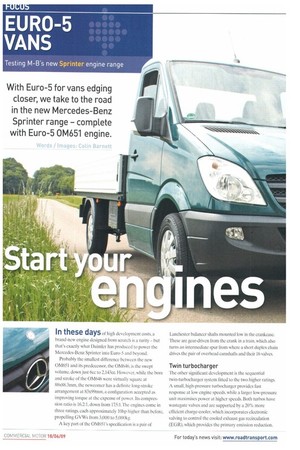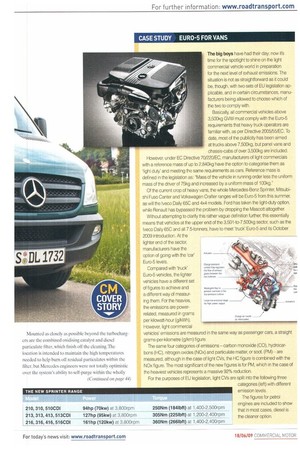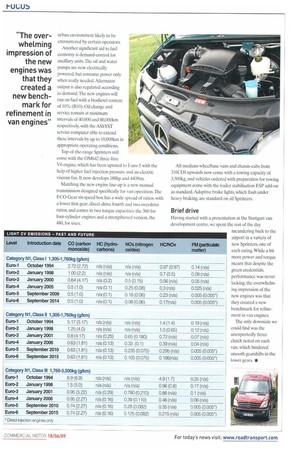With Euro-5 for vans edging closer, we take to the
Page 42

Page 43

Page 44

If you've noticed an error in this article please click here to report it so we can fix it.
road in the new Mercedes-Benz Sprinter range complete with Euro-5 0M651 engine.
Words / Images: Colin Barnet' In these days of high development costs, a brand-new engine designed from scratch is a rarity — but that's exactly what Daimler has produced to power the Mercedes-Benz Sprinter into Euro-5 and beyond.
Probably the smallest difference between the new 0M651 and its predecessor, the 0M646, is the swept volume. down just 6cc to 2,143cc. However, while the bore and stroke of the 0M646 were virtually square at 88x88.3mm, the newcomer has a definite long-stroke arrangement at 83x99mm, a configuration accepted as improving torque at the expense of power. Its compression ratio is 16.2:1, down from 17.5:1.Tlie engines come in three ratings. each approximately 10hp higher than before, propelling GVA's from 3,000 to 5,000kg.
A key part of the 0M651's specification is a pair of Lanchester balancer shafts mounted low in the crankcase. These are gear-driven from the crank in a train, which also turns an intermediate spur from where a short duplex chain drives the pair of overhead camshafts and their 16 valves.
Twin turbocharger
The other significant development is the sequential twin-turbocharger system fitted to the two higher ratings. A small, high-pressure turbocharger provides fast response at low engine speeds, while a larger low-pressure unit maximises power at higher speeds. Both turbos have wastegate valves and are supported by a 20% more efficient charge-cooler, which incorporates electronic valving to control the cooled exhaust gas recirculation (EGR). which provides the primary emission reduction. Mounted as closely as possible beyond the turbochargers are the combined oxidising catalyst and diesel particulate filter, which finish off the cleaning The location is intended to maintain the high temperatures needed to help burn off residual particulates within the filter, but Mercedes engineers were not totally optimistic over the system's ability to self-purge within the wholly urban environment likely to be encountered by certain operators.
Another significant aid to fuel economy is demand-control for ancillary units. The oil and water pumps are now electrically powered, but consume power only when really needed. Alternator output is also regulated according to demand. The new engines will run on fuel with a biodiesel content of 10% (B10). Oil change and service remain at minimum intervals of 40,000 and 80,000km respectively, with the ASSYST service computer able to extend these intervals by up to 10,000Iun in appropriate operating conditions.
Top-of-the-range Sprinters still come with the 0M642 three-litre Vh engine, which has been uprated to Euro-5 with the help of higher fuel injection pressure and an electric viscous fan. It now develops I88hp and 440Nm.
Matching the new engine line-up is a new manual transmission designed specifically for van operation.The ECO Gear six-speed box has a wide spread of ratios, with a lower first gear, direct-drive fourth and two overdrive ratios, and comes in two torque capacities: the 360 for four-cylinder engines and a strengthened version, the 480, for sixes. All medium-wheelbase vans and chassis-cabs from 316CDI upwards now come with a towing capacity of 3,500kg, and vehicles ordered with preparation for towing equipment come with the trailer stabilisation ESP add-on as standard. Adaptive brake lights, which flash under heavy braking, are standard on all Sprinters.
Brief drive
Having started with a presentation at the Stuttgart van development centre, we spent the rest of the day meandering back to the airport in a variety of new Sprinters, one of each rating. While a bit more power and torque 0.14 (n/a) meant that despite the green credentials, 0.08 (Na) performance was never 0.05 (n/a) lacking, the overwhelm 0.025 (n/a) ing impression of the 0.005(0,005*) new engines was that they created a new benchmark for refinement in van engines.
The only downside we could find was the unexpectedly fierce clutch noted on each van, which hindered smooth gearshifts in the lower gears. •
























































































































































